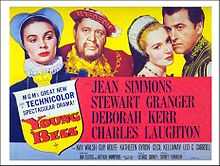Young Bess
| Young Bess | |
|---|---|
 Lobby card | |
| Directed by | George Sidney |
| Produced by | Sidney Franklin |
| Written by |
Jan Lustig Arthur Wimperis |
| Based on | Margaret Irwin (novel) |
| Starring |
Jean Simmons Stewart Granger Deborah Kerr Charles Laughton |
| Music by | Miklós Rózsa |
| Cinematography | Charles Rosher |
| Editing by | Ralph E. Winters |
| Distributed by | Metro-Goldwyn-Mayer |
| Release dates | May 21, 1953 |
| Running time | 112 minutes |
| Country | United States |
| Language | English |
| Budget | $2,423,000[1] |
| Box office | $4,095,000[1] |
Young Bess is a 1953 Technicolor biographical film made by Metro-Goldwyn-Mayer about the early life of Elizabeth I, from her turbulent childhood to the eve of her accession to the throne of England. The film starred Jean Simmons and Stewart Granger as Thomas Seymour, with Charles Laughton as Elizabeth's father, Henry VIII, a part he had played twenty years before in The Private Life of Henry VIII. The film was directed by George Sidney and produced by Sidney Franklin, from a screenplay by Jan Lustig and Arthur Wimperis based on the novel by Margaret Irwin (1944).
Plot
Following the execution of her mother, Anne Boleyn (Elaine Stewart), for infidelity, Elizabeth (Jean Simmons) is exiled to Hatfield House and declared illegitimate (thereby losing her place in line for the throne) by her father, King Henry VIII (Charles Laughton). She is accompanied by her loyal servants, Mr. Parry (Cecil Kellaway) and her governess Mrs. Ashley (Kay Walsh). Over the years, her position rises and falls on the whim of her father.
The child is periodically summoned back to London to become acquainted with Henry's latest spouse. When Henry marries his last wife, Catherine Parr (Deborah Kerr), the now-teenage Elizabeth finally rebels against her latest summons. However, the suave, handsome Lord Admiral Thomas Seymour (Stewart Granger) persuades her to change her mind, and Elizabeth and Catherine become good friends. Meanwhile, Henry is impressed and amused by the resolute defiance of his daughter (once again declared legitimate).
When Henry dies, Thomas's scheming brother Ned (Guy Rolfe) takes over as Lord Protector and guardian of King Edward VI (Rex Thompson) during his minority, overriding Henry's wish that Thomas raise the boy. Ned and Thomas do not like each other, and Ned's fear of his brother's ambition grows with each of Thomas's naval triumphs.
By now, Elizabeth realizes she is in love with Thomas. She refuses to believe Mrs. Ashley's warning that he loves someone else until she sees Thomas and Catherine embrace in secret. Ned had blocked Thomas from marrying into the royal family, but Elizabeth graciously persuades her brother to issue a royal decree sanctioning their marriage. As they live in the same household, Thomas grows too close to Elizabeth without even knowing it, until one day, Elizabeth kisses him and declares her love for him. She then wisely moves back to Hatfield.
Soon after, however, Catherine sickens and dies. Thomas comes to see Elizabeth. Ned has him arrested and charged with treason. He also accuses Elizabeth of plotting with Thomas to overthrow her brother. She goes to see Edward, but is too late to save Thomas from execution.
The film then shifts forward to 1558. Having survived the perils of her early life, and with Edward deceased and her elder sister Mary dying, Elizabeth is about to become Queen of England.
Cast




- Kay Walsh as Mrs. Ashley
- Guy Rolfe as Edward "Ned" Seymour
- Kathleen Byron as Anne Seymour, Ned's wife
- Cecil Kellaway as Mr. Parry
- Rex Thompson as Edward VI
- Robert Arthur as Barnaby, Thomas's page
- Leo G. Carroll as Mr. Mums, Elizabeth's tutor
- Norma Varden as Lady Tyrwhitt
- Alan Napier as Robert Tyrwhitt
- Noreen Corcoran as Bess as a child
- Ivan Triesault as Danish Envoy
- Elaine Stewart as Anne Boleyn
- Dawn Addams as Catherine Howard
- Doris Lloyd as Mother Jack
- Lumsden Hare as Archbishop Thomas Cranmer
- Lester Matthews as Sir William Paget
- Ann Tyrrell as Mary
Reception
According to MGM records, the film earned $1,645,000 in North America and $2,450,000 elsewhere, leading to a loss of $272,000.[1]
Awards
The film was nominated for two Academy Awards; for Best Costume Design and Best Art Direction (Cedric Gibbons, Urie McCleary, Edwin B. Willis, Jack D. Moore).[2]
See also
References
- ↑ 1.0 1.1 1.2 'The Eddie Mannix Ledger’, Margaret Herrick Library, Center for Motion Picture Study, Los Angeles
- ↑ "NY Times: Young Bess". NY Times. Retrieved 2008-12-21.
Further reading
- Monder, Eric (1994). George Sidney:a Bio-Bibliography. Greenwood Press. ISBN 9780313284571.
External links
| Wikimedia Commons has media related to Young Bess. |
- Young Bess at the Internet Movie Database
- Young Bess at the TCM Movie Database
- Young Bess at allmovie
| |||||||||||